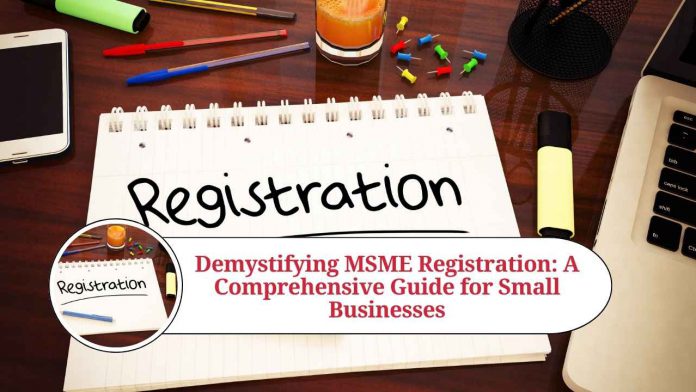Introduction:
Micro, Small, and Medium Enterprises (MSMEs) play a vital role in driving economic growth, fostering innovation, and generating employment opportunities. To provide support and recognition to these enterprises, governments around the world have implemented various schemes and initiatives. In India, the MSME sector is considered the backbone of the economy, and the Government of India has introduced a simplified registration process to encourage and empower small businesses. In this blog, we will delve into the details of MSME registration, its benefits, and the step-by-step procedure to obtain it.
What is MSME Registration?
MSME registration is a voluntary process designed to provide recognition to micro, small, and medium enterprises. It is an official acknowledgment by the government that the enterprise falls under the defined MSME category. The registration offers various benefits, including financial assistance, access to subsidies, credit support, and ease of doing business.
Benefits of MSME Registration:
- Collateral-free loans: Registered MSMEs can avail of collateral-free loans under various government schemes, promoting financial inclusion and enabling business growth.
- Credit support and subsidies: MSMEs enjoy priority sector lending from banks, lower interest rates, and subsidies on various government schemes and initiatives.
- Government tenders and procurement: MSMEs have exclusive access to participate in government tenders and procurement processes, opening up new business opportunities.
- Protection against delayed payments: The Micro, Small and Medium Enterprises Development (MSMED) Act safeguards registered MSMEs against delayed payments, ensuring timely cash flow.
- Income tax benefits: The government provides income tax exemptions, capital gains tax benefits, and tax rebates to encourage MSME growth.
- Technology and skill development: Registered MSMEs receive assistance and support for technology upgrades, research and development, and skill enhancement.
Eligibility Criteria:
To be eligible for MSME registration, an enterprise must fall within the defined investment and turnover limits:
- Micro Enterprise: Investment up to Rs. 1 crore and turnover up to Rs. 5 crore.
- Small Enterprise: Investment up to Rs. 10 crore and turnover up to Rs. 50 crore.
- Medium Enterprise: Investment up to Rs. 50 crore and turnover up to Rs. 250 crore.
Documents Required for MSME Registration:
- Aadhaar card of the applicant
- PAN card of the enterprise
- Business address proof
- Copies of bills related to the purchase of machinery or equipment (if applicable)
- Partnership deed or Memorandum of Association and Articles of Association (for companies)
- Incorporation certificate (for companies)
Step-by-Step Procedure for MSME Registration:
Online Registration Process:
Step 1: Visit the official MSME registration portal (https://udyamregistration.gov.in/).
Step 2: Click on the “New Registration” button.
Step 3: Fill in the required details, including Aadhaar number, name of the entrepreneur, PAN number, and business address.
Step 4: Verify the Aadhaar details through OTP authentication.
Step 5: Enter the enterprise’s details, including type, PAN, and bank account information.
Step 6: Provide information about the business activity, investment, and employees.
Step 7: Upload the necessary documents as per the checklist.
Step 8: Review and verify the entered details for accuracy.
Step 9: Make the payment for registration fees, if applicable.
Step 10: Submit the application.
Step 11: On successful submission, an acknowledgement number will be generated, which can be used to track the status of the registration application.
Offline Registration Process:
Step 1: Visit the nearest District Industries Center (DIC) or MSME Development Institute (MSME-DI).
Step 2: Collect the MSME registration form or download it from the official website.
Step 3: Fill in the required details, including personal information, business information, investment, and turnover.
Step 4: Attach the necessary documents, as mentioned in the registration form.
Step 5: Submit the completed application form along with the supporting documents to the relevant office.
Step 6: Pay the prescribed registration fees, if applicable.
Step 7: Upon verification, the MSME registration certificate will be issued.
Conclusion:
MSME registration serves as a gateway to a wide range of benefits and support for small businesses. By obtaining this registration, enterprises can access financial assistance, subsidies, and government schemes, thus paving the way for growth and success. Whether through the online or offline process, businesses can follow the step-by-step procedure mentioned above to register themselves as MSMEs. It is important for small enterprises to leverage this opportunity and leverage the advantages offered by the government to thrive in the competitive market and contribute to the nation’s economic development.
Read more useful content:
Frequently Asked Questions (FAQs)
Q1: What is the validity period of the MSME registration certificate?
A1: The MSME registration certificate is valid for a lifetime and does not require renewal.
Q2: Can a business apply for MSME registration if it is already registered under other government schemes?
A2: Yes, businesses can apply for MSME registration even if they are registered under other government schemes or have obtained other certifications.
Q3: Is there any fee for MSME registration?
A3: The registration process is free of cost on the official government portal. However, some third-party service providers may charge a nominal fee for assisting with the registration process.
Q4: Can a business register as an MSME if it operates in the service sector?
A4: Yes, businesses operating in both the manufacturing and service sectors are eligible for MSME registration.
Q5: Can a business change its registered address after obtaining MSME registration?
A5: Yes, businesses can update their registered address by submitting the necessary documents to the concerned authorities.
Q6: Can a sole proprietorship firm apply for MSME registration?
A6: Yes, sole proprietorship firms are eligible to apply for MSME registration. The proprietor’s Aadhaar card can be used for registration.
Q7: Can an MSME registration be canceled or revoked?
A7: Yes, if a business no longer meets the eligibility criteria or provides false information during registration, the MSME registration can be canceled or revoked by the authorities.
Q8: Can a business with an existing GST registration still apply for MSME registration?
A8: Yes, having a GST registration does not prevent a business from applying for MSME registration. Both registrations can coexist.
Q9: Is MSME registration mandatory for availing bank loans?
A9: While it is not mandatory, MSME registration can significantly enhance the chances of obtaining collateral-free loans and favorable terms from banks and financial institutions.
Q10: Can a business register as an MSME if it is in the process of incorporation?
A10: No, businesses need to be formally registered and operational before applying for MSME registration. The incorporation certificate is one of the required documents for registration.




















